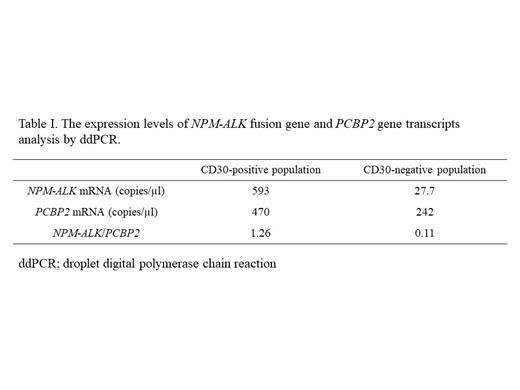Abstract
The small cell variant of anaplastic lymphoma kinase (ALK)-positive anaplastic large cell lymphoma (SC-ALCL) is a subtype defined as comprising two distinct tumor cell populations in immunohistochemistry: small cells staining negative or weakly positive for ALK and CD30 protein; and large cells staining strongly positive for those proteins. Although the constitution of these two different cell populations might contribute to the poor prognosis, detailed characterization of each population by molecular-based approaches has not been done due to the difficulty of cell separation from solid tumor sample. In this paper, we have analyzed the characterization of each tumor cell population using the patient sample from SC-ALCL leukemic phase obtained from peripheral blood by molecular-based approaches. Flow cytometric analysis revealed two distinct abnormal populations. The major population comprising 74% of total leukocytes was positive for CD3 and CD8, and negative for CD4, CD5, CD25 and CD30. The minor population comprising 5% of total leukocytes was positive for CD25, CD30, CD11b and CD13. Fluorescent in situ hybridization with ALK break-apart probes and RT-PCR analysis confirmed that most of the cells including both populations were rearranged with NPM-ALK gene. To elucidate the cause underlying the distinct levels of ALK protein expression in each population, we separated those tumor cells by CD30-PE antibody and a magnetic bead separation kit, extracted DNA and RNA from each population, and compared NPM-ALK mRNA expression levels by droplet digital polymerase chain reaction. The expression level of NPM-ALK mRNA in the CD30-negative population was ten-fold less than that in the CD30-positive population (Table). This result indicated that the two tumor cell populations expressed the distinct level of NPM-ALK mRNA, although both populations possessed NPM-ALK fusion gene. To assess the effectiveness of various chemotherapies in each tumor cell population, we monitored each population in peripheral blood by flow cytometric analysis (small cell; CD30-5-8+, large cell; CD30+) over time. Intriguingly, CD30-negative population behaved as chemo-resistant cells in clinical course, however alectinib, a second-generation ALK-inhibitor, eradicated both populations inducing first complete remission. This study revealed two definitive features regarding the small CD30-negative population of SC-ALCL, with a lower expression level of NPM-ALK mRNA transcripts and chemoresistance. The cause of distinct ALK staining levels in immunohistochemistry was revealed depending on the distinct expression level of NPM-ALK mRNA transcripts. Finally, since both populations were sensitive to ALK-inhibitor, early administration of ALK-inhibitor might be the reasonable option for SC-ALCL.
No relevant conflicts of interest to declare.


This feature is available to Subscribers Only
Sign In or Create an Account Close Modal